3.3: Soil Reclamation and Remediation of Disturbed Lands
- Page ID
- 16620
\( \newcommand{\vecs}[1]{\overset { \scriptstyle \rightharpoonup} {\mathbf{#1}} } \)
\( \newcommand{\vecd}[1]{\overset{-\!-\!\rightharpoonup}{\vphantom{a}\smash {#1}}} \)
\( \newcommand{\id}{\mathrm{id}}\) \( \newcommand{\Span}{\mathrm{span}}\)
( \newcommand{\kernel}{\mathrm{null}\,}\) \( \newcommand{\range}{\mathrm{range}\,}\)
\( \newcommand{\RealPart}{\mathrm{Re}}\) \( \newcommand{\ImaginaryPart}{\mathrm{Im}}\)
\( \newcommand{\Argument}{\mathrm{Arg}}\) \( \newcommand{\norm}[1]{\| #1 \|}\)
\( \newcommand{\inner}[2]{\langle #1, #2 \rangle}\)
\( \newcommand{\Span}{\mathrm{span}}\)
\( \newcommand{\id}{\mathrm{id}}\)
\( \newcommand{\Span}{\mathrm{span}}\)
\( \newcommand{\kernel}{\mathrm{null}\,}\)
\( \newcommand{\range}{\mathrm{range}\,}\)
\( \newcommand{\RealPart}{\mathrm{Re}}\)
\( \newcommand{\ImaginaryPart}{\mathrm{Im}}\)
\( \newcommand{\Argument}{\mathrm{Arg}}\)
\( \newcommand{\norm}[1]{\| #1 \|}\)
\( \newcommand{\inner}[2]{\langle #1, #2 \rangle}\)
\( \newcommand{\Span}{\mathrm{span}}\) \( \newcommand{\AA}{\unicode[.8,0]{x212B}}\)
\( \newcommand{\vectorA}[1]{\vec{#1}} % arrow\)
\( \newcommand{\vectorAt}[1]{\vec{\text{#1}}} % arrow\)
\( \newcommand{\vectorB}[1]{\overset { \scriptstyle \rightharpoonup} {\mathbf{#1}} } \)
\( \newcommand{\vectorC}[1]{\textbf{#1}} \)
\( \newcommand{\vectorD}[1]{\overrightarrow{#1}} \)
\( \newcommand{\vectorDt}[1]{\overrightarrow{\text{#1}}} \)
\( \newcommand{\vectE}[1]{\overset{-\!-\!\rightharpoonup}{\vphantom{a}\smash{\mathbf {#1}}}} \)
\( \newcommand{\vecs}[1]{\overset { \scriptstyle \rightharpoonup} {\mathbf{#1}} } \)
\( \newcommand{\vecd}[1]{\overset{-\!-\!\rightharpoonup}{\vphantom{a}\smash {#1}}} \)
\(\newcommand{\avec}{\mathbf a}\) \(\newcommand{\bvec}{\mathbf b}\) \(\newcommand{\cvec}{\mathbf c}\) \(\newcommand{\dvec}{\mathbf d}\) \(\newcommand{\dtil}{\widetilde{\mathbf d}}\) \(\newcommand{\evec}{\mathbf e}\) \(\newcommand{\fvec}{\mathbf f}\) \(\newcommand{\nvec}{\mathbf n}\) \(\newcommand{\pvec}{\mathbf p}\) \(\newcommand{\qvec}{\mathbf q}\) \(\newcommand{\svec}{\mathbf s}\) \(\newcommand{\tvec}{\mathbf t}\) \(\newcommand{\uvec}{\mathbf u}\) \(\newcommand{\vvec}{\mathbf v}\) \(\newcommand{\wvec}{\mathbf w}\) \(\newcommand{\xvec}{\mathbf x}\) \(\newcommand{\yvec}{\mathbf y}\) \(\newcommand{\zvec}{\mathbf z}\) \(\newcommand{\rvec}{\mathbf r}\) \(\newcommand{\mvec}{\mathbf m}\) \(\newcommand{\zerovec}{\mathbf 0}\) \(\newcommand{\onevec}{\mathbf 1}\) \(\newcommand{\real}{\mathbb R}\) \(\newcommand{\twovec}[2]{\left[\begin{array}{r}#1 \\ #2 \end{array}\right]}\) \(\newcommand{\ctwovec}[2]{\left[\begin{array}{c}#1 \\ #2 \end{array}\right]}\) \(\newcommand{\threevec}[3]{\left[\begin{array}{r}#1 \\ #2 \\ #3 \end{array}\right]}\) \(\newcommand{\cthreevec}[3]{\left[\begin{array}{c}#1 \\ #2 \\ #3 \end{array}\right]}\) \(\newcommand{\fourvec}[4]{\left[\begin{array}{r}#1 \\ #2 \\ #3 \\ #4 \end{array}\right]}\) \(\newcommand{\cfourvec}[4]{\left[\begin{array}{c}#1 \\ #2 \\ #3 \\ #4 \end{array}\right]}\) \(\newcommand{\fivevec}[5]{\left[\begin{array}{r}#1 \\ #2 \\ #3 \\ #4 \\ #5 \\ \end{array}\right]}\) \(\newcommand{\cfivevec}[5]{\left[\begin{array}{c}#1 \\ #2 \\ #3 \\ #4 \\ #5 \\ \end{array}\right]}\) \(\newcommand{\mattwo}[4]{\left[\begin{array}{rr}#1 \amp #2 \\ #3 \amp #4 \\ \end{array}\right]}\) \(\newcommand{\laspan}[1]{\text{Span}\{#1\}}\) \(\newcommand{\bcal}{\cal B}\) \(\newcommand{\ccal}{\cal C}\) \(\newcommand{\scal}{\cal S}\) \(\newcommand{\wcal}{\cal W}\) \(\newcommand{\ecal}{\cal E}\) \(\newcommand{\coords}[2]{\left\{#1\right\}_{#2}}\) \(\newcommand{\gray}[1]{\color{gray}{#1}}\) \(\newcommand{\lgray}[1]{\color{lightgray}{#1}}\) \(\newcommand{\rank}{\operatorname{rank}}\) \(\newcommand{\row}{\text{Row}}\) \(\newcommand{\col}{\text{Col}}\) \(\renewcommand{\row}{\text{Row}}\) \(\newcommand{\nul}{\text{Nul}}\) \(\newcommand{\var}{\text{Var}}\) \(\newcommand{\corr}{\text{corr}}\) \(\newcommand{\len}[1]{\left|#1\right|}\) \(\newcommand{\bbar}{\overline{\bvec}}\) \(\newcommand{\bhat}{\widehat{\bvec}}\) \(\newcommand{\bperp}{\bvec^\perp}\) \(\newcommand{\xhat}{\widehat{\xvec}}\) \(\newcommand{\vhat}{\widehat{\vvec}}\) \(\newcommand{\uhat}{\widehat{\uvec}}\) \(\newcommand{\what}{\widehat{\wvec}}\) \(\newcommand{\Sighat}{\widehat{\Sigma}}\) \(\newcommand{\lt}{<}\) \(\newcommand{\gt}{>}\) \(\newcommand{\amp}{&}\) \(\definecolor{fillinmathshade}{gray}{0.9}\)M. Anne Naeth, P. Michael Rutherford, and Allen M. Jobson
Learning Objectives
Upon completion of this chapter, students will be able to:
- Define and differentiate common terms such as reclamation, remediation, and restoration
- Describe the goals of reclamation and remediation
- Understand how fundamental concepts in soils apply to reclamation and remediation
- Understand the basics of common chemical, physical, and biological remediation strategies
- Understand the challenges of reclamation and remediation and how to address them
- Understand the beneficial use of waste materials and other amendments in reclamation and remediation
INTRODUCTION
Soil reclamation and soil remediation are components of the land reclamation process that take place on the landscape after disturbance of ecosystems and sites. These processes are critical to overall land reclamation success and are built around the premise that we can manipulate and accelerate soil development processes by altering specific soil properties.
Land reclamation is the process of converting disturbed or damaged land to its former or other productive uses. Reclamation encompasses all disturbed components of an ecosystem, including but not limited to, soils, hydrology, flora, and fauna.
Ecological restoration is the process of assisting recovery and management of ecological integrity; ecological integrity includes a critical range of variability in biodiversity, ecological processes and structures, regional and historical context, and sustainable cultural practices (Gann et al., 2019).
Remediation is the process of improving a contaminated site to prevent, minimize, or mitigate damage to human health and/or the environment. Contamination may be present in soils, surface water, and/or ground water. Soil remediation refers to a wide range of strategies that remove, destroy, contain, transform, or reduce availability of soil contaminants to humans and other receptors in the environment. These strategies may be conducted in situ or ex situ.
Revegetation is the process of providing barren or denuded land with a vegetation cover which replaces or tries to replicate pre-disturbance ground cover. Revegetation may be part of the reclamation strategy to reclaim or remediate soils.
Land reclamation is the umbrella term, with ecological restoration being a specific type of reclamation. Remediation and revegetation are specific components of the overall process.
Reclamation and remediation are usually associated with criteria developed within various jurisdictions. In many jurisdictions, reclamation is required by regulatory bodies. Normally these requirements are to return the land to equivalent capability, land performance that focuses on the degree and nature of limitation imposed by the physical characteristics of a land unit on a certain use, assuming a specific management system.
DISTURBANCES REQUIRING LAND RECLAMATION
Disturbance refers to variation in some ecosystem factor beyond its normal range of variation resulting in ecosystem change. A change in a system that interferes with its capacity to maintain a maximum range of tolerances for life, is known as degradation. Destruction refers to the complete degradation of a system to the point that it would have to be rebuilt to be useful, including changing of one ecosystem for development of another.
Disturbances can occur on the landscape as a result of human activities, such as mining, agriculture, and building of cities, towns, roads, pipelines, and power transmission lines. Surface mining generally causes more extensive landscape disturbance than underground mining. Disturbances can also occur from natural events such as floods, fires, hurricanes, and landslides. The intensity and properties of the disturbance will determine whether the land is degraded and whether human intervention is required to ameliorate the disturbance.
Soil disturbances change physical, chemical, and/or biological properties. For example, soil pH may be high or low relative to that tolerated by plants, soil fauna, or microorganisms. Salt contaminants may increase soil electrical conductivity. Physical mixing of horizons may occur when trenches or mines are dug, changing water and nutrient holding capacity. Use of heavy equipment can compact soils, increasing soil bulk density and penetration resistance, and reducing infiltration and percolation rates. Many of these changes can have serious impacts on plant rooting and microbial community function.
As land reclamation has become a requirement of companies seeking to alter the landscape for natural resource operations and/or land use changes, disturbances have become minimized and more controlled. In this way, land reclamation is easier to accomplish and the environmental impacts of the disturbance are reduced. Soil handling is one of the most important considerations in disturbances for natural resource extraction, and one that can be managed.
Disturbances associated with oil and gas operations, such as pipelines and well sites, now have strict construction guidelines in most jurisdictions. For example, soil salvage is mandatory and requires horizons of soil (layers) to be removed and stored separately. Upon pipeline installation or well site decommissioning, the soil horizons are required to be replaced in proper order.
Surface mining is considered one of the most intensive human disturbances on a landscape due to its aerial extent and size of the excavation. Although soils are stripped and require replacement to mimic the pre-disturbance condition, there is often a shortage of soil due to the mined material being removed from the system. Since the excavations are so large, there are major disruptions of the hydrologic regime. Excavations through overburden to desired ore bearing rock, minerals, coal, or bitumen create vast volumes of waste rock, unconsolidated soil materials, and/or tailings materials. Bitumen mining (oil sands) results in overburden and tailings ponds. These intense disturbances often require soil building and creation of end pit lakes to accommodate soil loss.
SOIL RECLAMATION
Soil reclamation is part of the overall land reclamation process and is usually addressed after removal of infrastructure, recontouring, and contaminant remediation, and before revegetation (Figure 16.1). An important concept in soil reclamation is end land use. Different criteria and reclamation processes may be followed depending on how the land will be used after reclamation. For example, regulatory requirements are more stringent for agricultural land and land that people will occupy than land used for industrial purposes. These potential end land uses can be similar to what was there prior to the disturbance or can require a complete change of ecosystem.
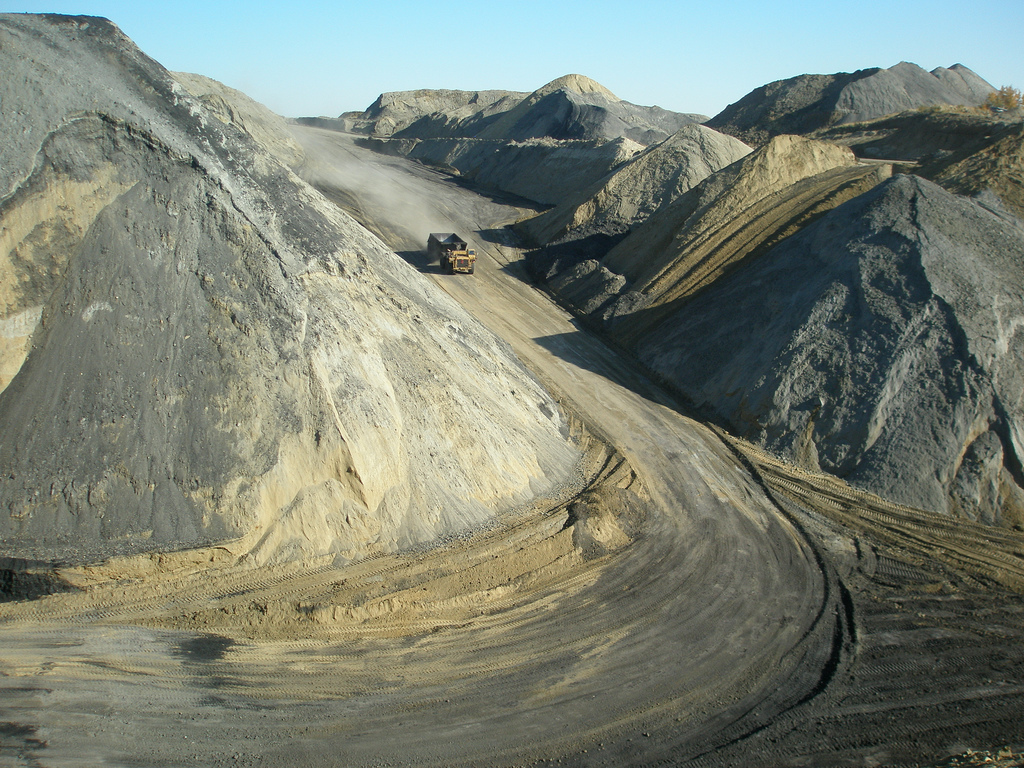
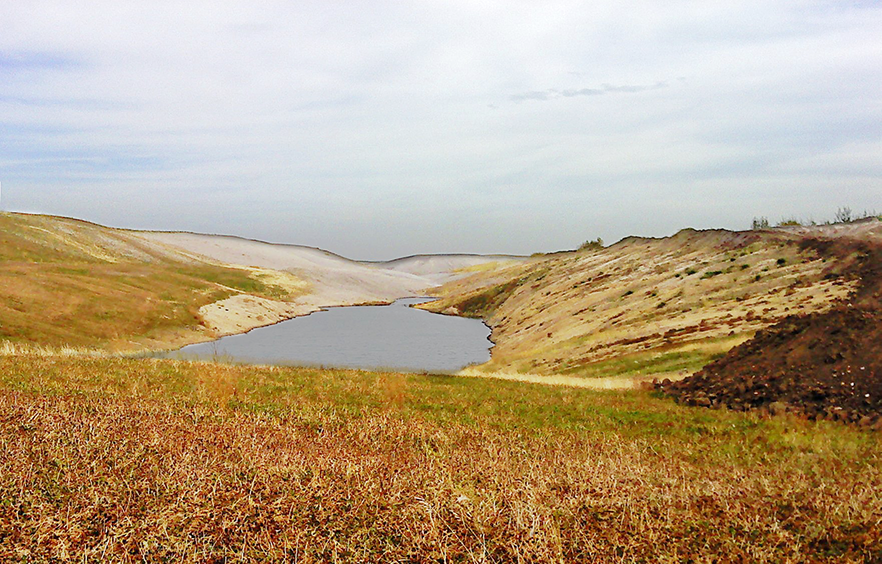
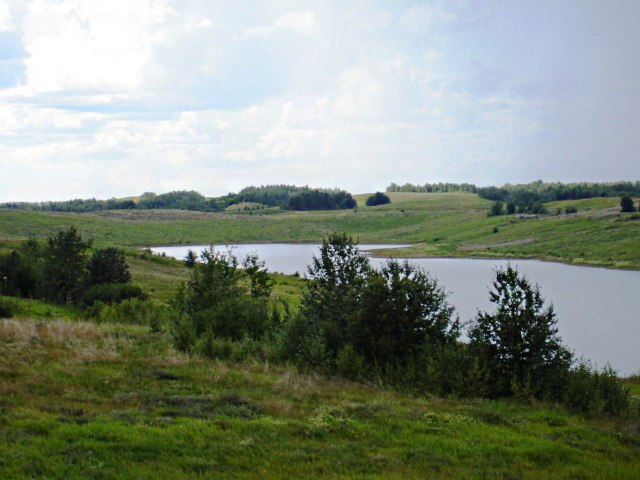
Soil Replacement and Amendments
When soil has been stripped in horizons and stockpiled during disturbance it is normally replaced in its natural horizon sequence. Although admixing of horizons can be an issue, careful placement techniques can mitigate it. The most likely issue is compaction when the soil is replaced and this can be mitigated through tillage operations. Much damage to soils can be reduced by having construction activities occur under frozen, or dry conditions. Soil quality can be retained if soils are stockpiled only for short periods of time.
If soil chemical properties do not meet end land use requirements, amendments can be used to bring soils to an appropriate criteria. A common issue in soil reclamation is lack of organic matter and impacts on its associated properties. This can be addressed by adding an organic amendment such as animal manure or straw from a local agricultural operation, or forest floor material (LFH) from an area that has been deforested. Another common issue is lack of soil nutrients necessary for revegetation. These deficiencies can best be addressed by adding commercial fertilizers composed of the necessary nutrients such as nitrogen, phosphorus, and potassium. Fertilizers can be formulated in bulk to meet specific needs of a reclamation site.
A common and environmentally important process is to use waste materials in soil reclamation. This has the added benefit of removing many materials from the landfills where they would otherwise be placed. Sewage is available from waste treatment facilities from most mine camps and is a good source of nutrients and organic matter (Figure 16.2). However, there are concerns with raw sewage use due to possible presence of salts, metals, and disease causing microorganisms. Biosolids are widely used as soil amendments. They are sewage sludges which have been treated to lower pathogen risk. Other amendments can be used in reclamation, including calcium sources, paper mill waste, industrial sludges, biochar, wood ash, and commercial products. Each have specific properties than can be aligned with the soil properties that need improvement, and each often come with associated negative properties that require balancing. Many jurisdictions have regulations or guidelines for use of wastes and industrial by-products as soil amendments.
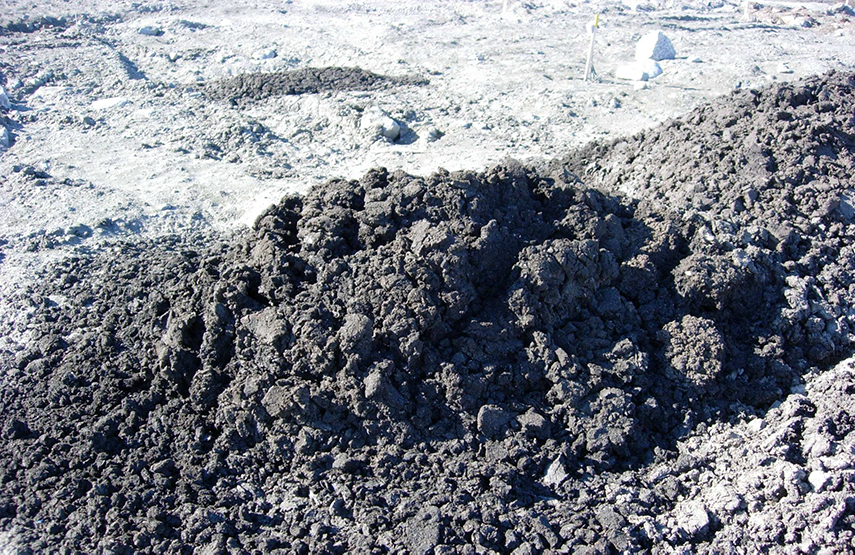
Topographic variability of features on a landscape, can play an important role in determining plant communities, as can the scale of these features. Thus, micro topographic variability is needed on the constructed, reclaimed landscape to provide micro sites for plants and microorganisms, to reduce erosion, and to be aesthetically pleasing. This can be provided through features such as mounds, furrows, depressions, rocks, boulders, coarse textured substrates, mulches, and cracks.
Soil Building
When there is insufficient soil to be replaced or amended after a large scale disturbance, soil must be constructed. These human constructed soils are called Anthroposols (Naeth et al., 2012). Anthroposols can include soils that have had layers (of at least 10 cm depth) removed or modified by human activity, or where manufactured materials have been added to soil; overall human activity has altered the soil forming factors and a new pedogenic trajectory may have been introduced. Anthroposols are classified at the great group level based on material composition of the layers, specifically organic carbon content and presence of anthropogenic artefacts (materials made by humans such as plastic, glass, garbage, concrete).
Soil building requires several steps. The end land use for the disturbed area is assessed and the appropriate soil for that purpose delineated. To build a soil requires a mineral substrate, which can generally be found or produced in large amounts, and it forms the main mass of an anthroposol. Amendments can be added in smaller amounts to improve physical, chemical, and/or biological properties such as nutrient content, infiltration capacity, or pH. Selection of appropriate amendments and substrates or combinations is based on physical and chemical properties, cost, and availability of materials. The materials and combinations of materials are layered similar to natural soil horizons or may be incorporated into the soil.
Use of waste materials to build anthroposols is increasingly common, especially when a local source is lacking. Various waste materials are produced from different industries and human activities, including crushed ore and waste rock (mining), pulp and paper sludge (paper milling), and sawdust and wood chips (lumber milling) (Figure 16.3). Sewage, biosolids, and compost can be sourced from urban or industrial sites, and manure from agricultural sources.
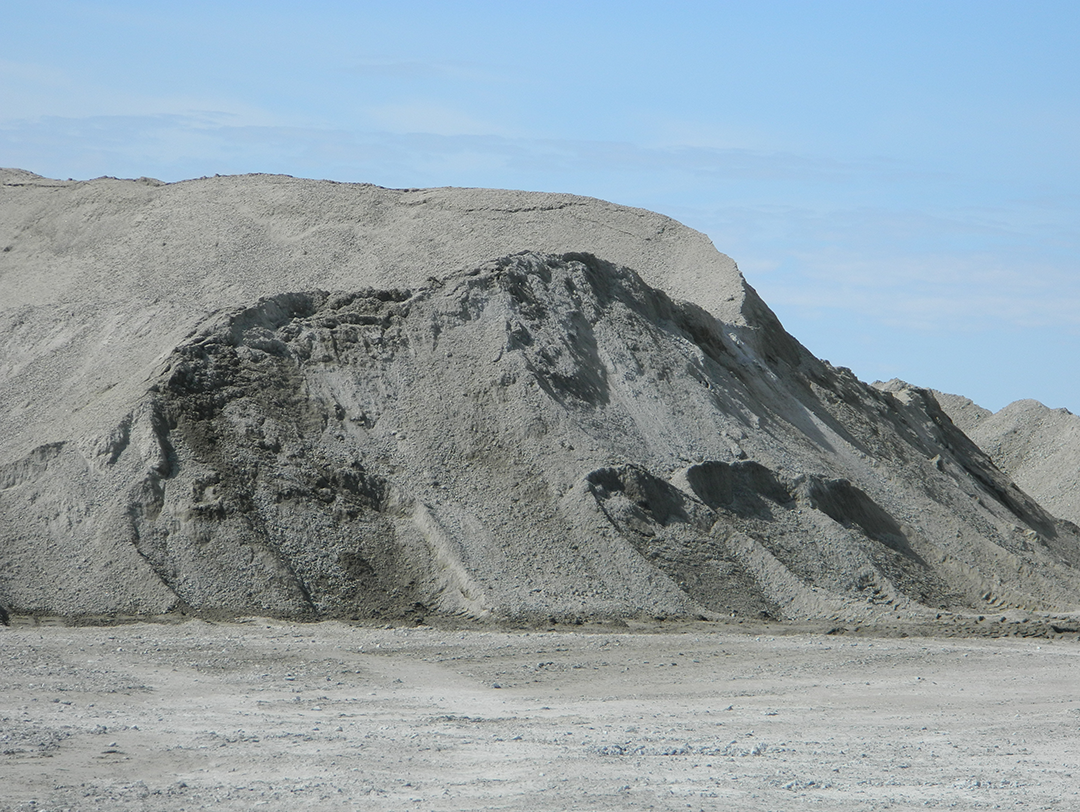
Mineral materials are highly variable due to differences in industrial practices (extraction, processing) and source (parent material, location). They often have low organic matter and nutrient content and poor water holding capacity. They can have elevated metals and cause acid mine drainage (sulphur rich rock).
Many chemical, physical, and biological soil properties must be considered when building anthroposols as they are commonly limiting factors, especially when using waste materials. For example, waste rock containing pyrites can cause acidity problems, and coarse textured materials usually have low nutrient and water holding capacity, and tend to be prone to erosion. Thus the soil amendments must be closely matched with the property changes that are needed in the reclamation soil, being careful not to add any other constraints.
Erosion Control
Erosion is a problem at most disturbed sites prior to and during reclamation as the soil is bare and devoid of vegetation, exposing the surface to wind and water erosion. Erosion can be reduced on reclamation sites with contouring, amendments, and various materials such as erosion control blankets, and mulch. Many techniques, called bioengineering, include use of plant materials with techniques such as live staking (i.e., planting individual live wood cuttings into the soil). Many erosion control products are very effective, although some can add considerable cost to the reclamation project.
SOIL REMEDIATION
Soils may become contaminated through a variety of means, broadly categorized as point sources or non-point sources. Point sources include leaking fuel storage tanks, spills at industrial sites, waste disposal areas, and landfill areas. Non-point sources include atmospheric deposition. Although soils may be contaminated with non-chemicals, such as harmful bacteria or viruses, chemical contaminants are often the main issue.
The Canadian Council of Ministers of the Environment defines contaminants as chemical substances whose concentration exceeds background concentrations or that do not naturally occur in the environment (CCME 1997). Contaminated soils contain chemical substances at concentrations considered unsafe by regulators. The term pollutant is sometimes used, and is defined as a chemical or substance out of place, or present at higher than normal concentrations, that has adverse effects on non-target organisms (Pierzinski et al., 2005).
Soil remediation strategies entail removal or destruction of contaminants, reducing mobility of contaminants, or transforming them to less toxic forms. The main goal is to minimize risk to humans and other receptors.
Common Soil Contaminants
Soil contaminants can be broadly grouped as organic and inorganic. Organic contaminants include pesticides, organic solvents, and other industrial products (Table 16.1). The most common organic contaminants (mass or volume) at contaminated sites in Canada are petroleum hydrocarbons (PHCs), including crude oil and refined products such as fuels and lubricating oils. Dioxins, furans, and polycyclic aromatic hydrocarbons (PAHs) are organic compounds.
Table 16.1. Common soil contaminants
| Common contaminants | Common sources |
|---|---|
| Organic contaminants | Refined and unrefined products, fuels, lubricants, oil |
| Petroleum hydrocarbons (PHCs) | Creosote, coal tar, asphalt, incomplete combustion, oil, wood |
| Polycyclic aromatic hydrocarbons (PAHs) | Degreasers, dry cleaning facilities, plastics industry |
| Halogenated hydrocarbons, aromatics | Electrical equipment, hydraulic oil |
| Chlorinated solvents | Incomplete combustion of waste containing chlorine |
| Polychlorinated biphenyls (PCBs) | Agriculture, pest control |
| Dioxins, furans | Chemical industries, military explosives |
| Pesticides | |
| Alcohols, ethers, nitrogen based | |
| Inorganic contaminants | Chemical, industrial, mine wastes, firing ranges, fly and bottom ash, metal recycling, battery disposal |
| Heavy and trace metals, metalloids | Acid rock drainage, chemical spills |
| Acids, bases | Biosolids, manures, salt storage, oil and gas industry |
| Excess nutrients and salts | Oil and gas, phosphate industry, uranium mining |
| Radionuclides | |
| (Adapted from Knox et al. 1999, CCME 2016) | |
Inorganic contaminants include metals or salts, often as anions or cations. They can be beneficial to soil ecosystems at background concentrations, although at high concentrations may pose a risk to human or non-human receptors. For example, copper, molybdenum, cobalt, and zinc are important plant micronutrients, but are contaminants at high concentrations. Non-metal anions such as chloride can build up in soils from de-icing operations or chemical spills. At high concentrations they can increase soil electrical conductivity or have direct impacts on plants.
High concentrations of nutrients such as nitrogen, phosphorus, and sulphur, can be considered contaminants. They originate from waste materials that are inappropriately stored or disposed of on land, such as livestock waste applied on agricultural land. Application of these waste materials can be part of remediation and reclamation processes of contaminated sites.
Properties of Soils and Contaminants Relevant to Remediation
Selecting an appropriate remediation strategy is dependent on contaminant and site properties, including soil properties. For example, petroleum hydrocarbons vary in molecular weight, water solubility, volatility, and density; gasoline tends to have lower molecular weight and higher volatility than lubricating oils. Larger hydrocarbon compounds tend to be less volatile and less water soluble than smaller ones. Large, non-soluble hydrocarbons can exhibit strong sorption (are sorbed) to native soil organic matter (high sorption coefficient) making them difficult to degrade or remove, particularly in fine textured soils due to greater sorption and potential for entrapment within soil aggregates, and reduced movement of air and water.
Inorganic contaminants, such as metals, can be present in different forms in soils. Distribution among the various components will be affected by soil texture, mineralogy, pH, cation and anion exchange capacity, organic matter content, and aeration status. Remediation strategies need to take the various forms of chemical species into consideration.
Remediation Strategies
Remediation strategies for contaminated soil can be broadly classified as biological, chemical, or physical (Table 16.2). Many are a combination of more than one type, and can be applied either ex situ or in situ. Ex situ methods involve excavating the soil from the impacted zone and treating the soil either on or off site. In situ methods treat the contaminated soil in place. Contaminated sites often have contaminated surface and ground waters that may require different or complementary remediation strategies.
Table 16.2. Common remediation strategies for contaminated soils
| Type | Category | Common contaminants | Location |
|---|---|---|---|
| Biological | Bioremediation, land farming, engineered biopiles or windrows | Petroleum hydrocarbons | Either |
| Bioventing | Petroleum hydrocarbons | In situ | |
| Phytoremediation (rhizodegradation, phytoextraction, phytodegradation, phytostabilization, phytoextraction) | Petroleum hydrocarbons, other organic contaminants, metals | Generally in situ | |
| Slurry phase reactors or lagoons | Various organics | Ex situ | |
| Chemical | Chemical oxidation / reduction | Organics, inorganics | Either |
| Neutralization | Acids, bases | Either | |
| Physical | Soil vapour extraction (SVE) | Volatile organics (gasoline) | In situ |
| Soil flushing, soil washing, dual phase extraction in ground water | Organics, inorganics | Either | |
| Solidification, stabilization | Organics, inorganics | Either | |
| Electrokinetic separation | Organics, inorganics | Either | |
| Thermal desorption | Organics | Either | |
| Incineration | Organics | Ex situ | |
| Vitrification | Organics, inorganics | Either |
Bioremediation is a biological treatment that uses soil microorganisms to treat contaminants. It can use natural biodegradation processes, or enhance them by adding commercial or other microbial preparations (bioaugmentation), or adding nutrients such as nitrogen or phosphorus and/or electron acceptors such as oxygen (biostimulation). Bioremediation strategies focus on microbial degradation of organic contaminants, although microbial induced chemical changes of inorganic chemicals can be considered bioremediation, such as converting more toxic chromium to the less toxic chromium.
Bioremediation can be applied in various technologies, such as landfarms, biopiles, or engineered reactors. Bioventing is an in situ treatment that enhances microbial degradation of contaminants through enhanced aeration in the contaminated zone. Use of plants to remove (phytoextraction), stabilize (phytostabilization), or destroy (phytodegradation) contaminants is a biological treatment called phytoremediation. Rhizosphere bacteria can play an important role in biodegradation of organic contaminants during phytoremediation (rhizodegradation).
Chemical treatments can be used to convert contaminants to non-hazardous or less toxic chemicals, or to forms which are less mobile, more stable, or inert. Chemical oxidation using hydrogen peroxide, ozone, or permanganate can destroy compounds such PAHs, and is best for liquids such as ground water or soil slurries. Chemical reduction can convert toxic chromium to less toxic chromium and degrade some chlorinated organic solvents such as trichlorothene. Neutralization involves adding materials to adjust the pH of highly acidic or caustic soil.
Physical treatments use properties of the contaminant or contaminated medium to separate or immobilize the contaminant. Chemical additives can improve removal efficiencies. In situ, soil vapour extraction creates a vacuum in the vadose zone, draws vapours into an extraction well, then treats or destroys them above ground. Soil flushing occurs in situ, where the contaminated zone is treated with a solution, and mobilized contaminants are brought to the surface for disposal, treatment, or re-circulation. Treatment solutions can be water, basic, acidic, chelating or complexing, reducing, co-solvents, or surfactants. Dual phase extraction involves installation of piping to ground water and vacuum extraction of water and organic contaminants such as petroleum hydrocarbons. Soil washing is done ex situ and may involve separating soil fines (silt, clay) from coarse material thereby reducing the total mass and volume that needs to be treated.
Solidification and stabilization prevent or slow release of contaminants from soil by treatment with binding agents such as cement or asphalt. The soil may be treated with a material that will reduce contaminant solubility and mobility. For example, phosphate based materials often reduce mobility of lead, by converting lead into insoluble lead phosphate compounds. Hydrogen sulphide can convert many metals into insoluble respective pyrites.
Electrokinetic separation sends a low intensity direct current through the soil to separate metals, radionuclides, and organic contaminants. Positively charged species migrate to the cathode, and negatively charged species, such as inorganic and organic anions, migrate to the anode.
Thermal treatments are mainly used to remediate organic contaminants. Thermal desorption is typically ex situ, with heat applied to soil to evaporate or vapourize contaminants which are collected, treated, or destroyed. Temperatures of 90 to 320°C are required to treat volatile organic contaminants such as fuel components, 320 to 540°C to treat semi-volatile organics such as PAHs, PCBs, and lubricants. Incineration involves heating soil ex situ to 870 to 1370°C to destroy organic contaminants. Vitrification heats soil to 1400 to 2000°C to melt silica and convert it to stable glass and crystalline solids. Heat may be generated by electrodes and electrical resistance or plasma arc technology. Organic contaminants are volatilized, trapped, and treated or destroyed and inorganic contaminants, including radionuclides, are encased.
Manipulating Soil Processes to Enhance Remediation
Understanding soil properties and processes facilitates remediation of contaminated soils. For example, in bioremediation of petroleum hydrocarbon contaminated soils, a parent hydrocarbon compound is biodegraded to a simpler one or degraded completely to carbon dioxide. Three main factors influencing organic contaminant biodegradation can be manipulated. They include compound or chemical properties such as solubility, molecular weight, and sorption potential; microbial capabilities, such as whether microorganisms have appropriate enzyme systems to biodegrade the compound; and environmental conditions such as temperature, and soil pH, electrical conductivity, aeration status, water content, nutrient content, organic matter content, texture, and structure.
Crude oil contains hundreds of individual compounds of various molecular sizes, branching, and solubility. Larger, more complex compounds are generally less soluble and more strongly sorbed (or partitioned) to soil. Most surface soil horizons contain a consortium of heterotrophic microorganisms capable of degrading petroleum hydrocarbons. Soil organisms can be inoculated into the soil (bioaugmentation) in the bioreactor or landfarm, with soil known to have petroleum degrading microorganisms. Petroleum hydrocarbon bioremediation works best if petroleum concentrations are not so high that free product is present; concentrations less than 10% by mass are ideal.
The soil environment may be manipulated to enhance biodegradation. Petroleum degradation is generally most rapid under warm, moist, aerobic conditions near neutral pH. Soil pH can be modified with lime, wood ash, or elemental sulphur. Most soil microorganisms are mesophiles and biodegradation can be optimized at 25 to 35°C. The reactor can be aerated to enhance oxygen levels, or heated in cold weather. Oxygen levels are between 1 and 10% in soil air and aerobic microbial activity is most rapid just below field capacity. Assuming no hydrophobicity, soil being land farmed or treated can be kept moist, near field capacity. Heterotrophic bacteria and fungi utilize petroleum hydrocarbons as a source of energy and carbon for growth. To create new cells, microorganisms need carbon, nitrogen, phosphorus, sulphur, and other nutrients. Nitrogen and sometimes phosphorus tend to be needed in greatest amounts; however, petroleum hydrocarbons are typically lacking in these elements. Crude oil typically has approximately 85% carbon. Assuming a carbon utilization efficiency of 50% and a mean cell C:N ratio of 10, microorganisms need approximately 1 mass unit of nitrogen per 20 mass units of petroleum carbon. Levels of 1 mass unit nitrogen per 40 to 50 mass units petroleum carbon may be sufficient as not all petroleum carbon will be degraded at the same rate. Nitrogen can be added as fertilizer such as urea or ammonium sulphate, or nitrogen rich organic sources such as manures and biosolids. Phosphorus should be available in a soil hydrocarbon mixture at an appropriate hydrocarbon carbon to phosphorus ratio of at least 50:1.
Not all petroleum hydrocarbons in soil are readily bioavailable. Compounds must come into contact with microbial enzymes for degradation to occur. Contaminants may be strongly sorbed to the soil, trapped within pores, or in a separate phase away from microorganisms and/or their enzymes. This partitioning or sorption effect is most prevalent for larger, hydrophobic petroleum compounds, and aged or weathered contaminated soils. For in situ hydrocarbon bioremediation as much free product hydrocarbon as possible should be removed through vacuum extraction, then the remaining adsorbed hydrocarbon can be addressed by bioremediation.
The soil can be manipulated to enhance bioavailability. Techniques include adding surfactants to decrease strong soil sorption and increase apparent solubility of petroleum hydrocarbons. Soil aggregates can be disrupted to improve contact between microbial enzymes and contaminants. Some systems, such as in slurry phase reactors, are ideal for this, but can greatly increase the treatment costs.
SUMMARY
- Soil reclamation and soil remediation are components of the land reclamation process whereby a disturbed landscape is returned to former or other productive uses; the goals of soil reclamation are dictated by the nature of the disturbance and the desired end land use.
- Soil reclamation of highly disturbed landscapes makes use of our understanding of soil formation and genesis; humans can accelerate soil forming processes in part through addition of various amendments, which includes utilization of various waste residuals and plants in the revegetation process.
- Anthroposols are soils which are built through human intervention.
- Soil remediation is a subcomponent of soil reclamation and is focused on removal, reduction, or containment of organic and/or inorganic contaminants with the goal of minimizing risk to humans and/or environmental receptors.
- A wide range of biological, chemical, and physical strategies are available to remediate contaminated soils; selection of the most appropriate technology is in part dictated by the nature of the contaminants and of the impacted soil and site.
- Bioremediation is a common approach to remediate petroleum hydrocarbon contaminated soils; the process can be optimized by manipulating soil and environmental conditions to enhance microbial degradation of the target compounds.
SUGGESTED READING
Alexander, M. 1999. Biodegradation and bioremediation. 2nd edition. Academic Press.
Adriano, D.C., J.M. Bollag, W.T. Frankerberger, and R.C. Sims. (co-editors). 1999. Bioremediation of contaminated soils. Agronomy Series 37. American Society of Agronomy, Crop Science Society of America, Soil Science Society of America, Madison, Wisconsin, USA.
Federal Remediation Technology Roundtable (FRTR). (ND). Remediation technologies screening matrix and reference guide 4.0. At https://frtr.gov/matrix2/section1/toc.html.
Naeth, M.A., H.A. Archibald, C.L. Nemirsky, L.A. Leskiw, J.A. Brierley, M.D. Bock, A.J. VandenBygaart, and D.S. Chanasyk. 2012. Proposed classification for human modified soils in Canada: anthroposolic order. Canadian Journal of Soil Science 92:7-18.
Pichtel, J. 2017. Fundamentals of site remediation. 2017. 2nd Edition. Government Institutes, an imprint of The Scarecrow Press Inc., Lanham, Maryland.
Reynolds, C.M. and H.D. Skipper. 2005. Bioremediation of contaminated soils. Pp 536-561 in Sylvia, D.M, P.G. Hartel Fuhrmann, and D.A. Zuberer. Principles and applications of soil microbiology. 2nd edition. Pearson Prentice Hall, Upper Saddle Riever, New Jersey.
Riser-Roberts, E. 1998. Remediation of petroleum contaminated soils – biological, physical and chemical processes. Lewis Publishers.
Suthersan, S.S., J. Horst, M. Schnobrich, N. Welty, and J. McDonaugh. 2017. Remediation engineering – design concepts. 2nd Edition. CRC Press, Taylor and Francis Group, Boca Raton, FL.
STUDY QUESTIONS
- A 1 ha well site lease with little topsoil requires straw to increase organic matter in the upper 0.15 m. The topsoil has 1% organic matter, bulk density 1.50 Mg m-3. Adjacent soils have 5% organic matter and this is required for the reclamation site. Determine the number of 1,200 lb round bales to get the upper 15 cm to 5% organic matter. To do this, calculate the mass of soil to be amended. Assume the organic carbon content of wheat straw is 45.5%. Account for mineralization given that bacterial respiration releases approximately 60% organic matter as CO2 and 40% into soil.
- Determine how much beef manure to apply to a fescue grassland, if incorporating into the soil 1 day after spreading. Assume recommended plant nutrient requirements for fescue grassland are 30 kg ha-1 nitrogen and 15 kg ha-1 P2O5.
- A study was done to determine how much fertilizer should be added to a field to maximize the bioremediation of crude oil that was spilled at an industrial site. A laboratory incubation showed that the maximum rate of petroleum hydrocarbon (PHC) biodegradation occurred when 25.0 mass units of contaminant carbon is treated with 1 mass unit of nitrogen. Based on this relationship, calculate how many tonnes of urea fertilizer (45-0-0) needs to be applied per hectare (ha) to treat the top 15.0 cm depth of a crude oil contaminated field (crude oil concentration is 1.25 g oil 100-g-1 dry soil = 1.25% by weight). The fertilizer will be mixed into the top 15.0 cm of the field using a disker or rototiller after surface application. The bulk density of the soil is 1.15 Mg m-3; and, the crude oil contains 85.0% carbon. Assume the N content of the urea is 45.0%
- A greenhouse experiment was conducted to determine the feasibility of using the plant Indian mustard (Brassica juncea) to phytoremediate a lead (Pb) contaminated soil (1640 mg lead kg-1 soil). Indian mustard was seeded into the contaminated soil (in 4 L pots) and pots were placed in the greenhouse for 12 weeks (were watered and fertilized as needed). At the end of the experiment, the plants were harvested and the average concentration of Pb was determined in the above ground biomass (roots left in soil). The Pb concentration in above ground biomass was 1215 mg kg-1 dry biomass. Assume that typical above ground yield for the region of interest is 10.0 tonnes dry biomass per ha per growing season; soil bulk density is 1.22 g cm-3 (1.22 Mg m-3), and Pb concentration in the field grown plants is equal to that in the greenhouse study. Calculate how many growing seasons (years) it would take the Indian mustard to reduce the soil Pb concentrations in a hectare furrow slice (HFS = 10,000 m2 x 0.15 m = 1500 m3 of soil) from 1625 to 300 mg Pb per kg of soil. In your opinion, is this remediation strategy practical for this level of Pb contamination?
REFERENCES
Canadian Council of Ministers of Environment (CCME). 1997. Guidance document on the management of contaminated sites in Canada. Canadian Council of Ministers of Environment PN 1279 C97-980244-X.
Canadian Council of Ministers of Environment (CCME). 2016. Guidance manual for environmental site characterization in support of environmental and human health risk assessment. Volume 1 guidance manual. Canadian Council of Ministers of Environment PN 1551 ISBN 978-1-77202-026-7 PDF.
Gann G.D., T. McDonald, B.Walder, J. Aronson, C.R. Nelson, J. Jonson, J.G. Hallett, C. Eisenberg, M.R. Guariguata, J. Liu, F. Hua, C. Echeverria, E.K. Gonzales, N. Shaw, K. Decleer, and K.W. Dixon. 2019. International principles and standards for the practice of ecological restoration. Second edition. Restoration Ecology S1-S46.
Knox, A.S., A.P. Gamerdinger, D.C. Adriano, R.K. Kolka, and D.I. Kaplan. 1999. Sources and practices contributing to soil contamination. Pp 53-87 in Adriano et al. (co-editors) Bioremediation of contaminated soils. Agronomy Series 37. American Society of Agronomy, Crop Science Society of America, Soil Science Society of America, Madison, Wisconsin, USA.
Pierzynski, G.M., J.T. Sims, and G.F. Vance. 2005. Soils and environmental quality. Taylor and Francis Group.
United States Environmental Protection Agency. 2017. Superfund remedy report. 15th edition. Office of Land Emergency Management, EPA-542-R-17-001. At: https://www.epa.gov/remedytech/superfund-remedy-report.
About the Authors
M. Anne Naeth, Professor, Department of Renewable Resources, University of Alberta, Edmonton, Alberta, Canada

Anne is a professional agrologist (PAg) and professional biologist (PBiol). She served as Associate Dean (Academic) and Associate Dean (Research and Graduate Studies). She worked in government and industry and served on the Alberta Environmental Appeals Board, on executives of numerous professional organizations and boards. Her land reclamation research program has led to extensive publications, policy changes, and development of a new soil order (Anthroposols). She has supervised over 75 graduate students and mentored dozens of postdoctoral fellows, research associates and undergraduates. She is a Vargo Distinguished Teaching Chair, Fellow of the Canadian Society of Soil Science, Fellow of the Society for Teaching and Learning in Higher Education, and recipient of numerous awards recognizing scholarship, teaching and community service, including the CLRA Noranda Land Reclamation Award, Mentors of the Millenium, Alumni Award of Excellence, Killam Professorship, Distinguished Agrologist, Rutherford Award of Excellence for Undergraduate Teaching, 18 Faculty Teacher of the Year Awards, the prestigious 3M Fellowship, and the University Cup (highest award from University of Alberta). She received the first University of Alberta NSERC CREATE grant to establish the Land Reclamation International Graduate School (LRIGS), the first school of its kind in the world for multi-disciplinary training and professional development of land reclamation students.
P. Michael Rutherford, Professor, Environmental Science Program, University of Northern British Columbia, Prince George, B.C., Canada

Mike joined the Environmental Science program at UNBC in 2001. He teaches and conducts research into topics related to soil science, environmental quality and waste management. His research has focused on a wide range of topics including: biological interactions in soils, carbon and nitrogen cycling, radon and natural-occurring radioactivity, remediation and reclamation, and, the beneficial use of residuals (such as wood ash) as soil amendments. He is a P.Ag. that enjoys working on practical issues related to soil science.
Allen M. Jobson, Retired Soil Microbiologist, Alumnus, University of Alberta, Edmonton, Alberta, Canada

Al joined the Alberta Research Council in 1975 as a petroleum bioremediation specialist, moving to the Alberta Environmental Research Center (Vegreville) in 1978 as Head of Environmental Microbiology. In pursuit of other interests in agriculture Al moved to Saskatchewan in 1980 and farmed until 1987. He conducted reduced rate herbicide application trials with shrouded sprayers throughout Saskatchewan for Rogers Engineering Ltd. (Saskatoon). In 1991 he joined Beak Associates in Saskatoon which became SENTAR, then Stanley Environmental, then STANTEC (1994). Al consulted widely on soil environmental remediation projects for STANTEC in Alberta, Saskatchewan, Manitoba, Nebraska and Idaho. In 2008 he joined Ostrem Chemical Co. Ltd. (Edmonton) as a Product Development Specialist designing more environmentally acceptable products. From 1998 to 2018 Al was an adjunct professor in the Department of Renewable Resources, Faculty of Agricultural, Life and Environmental Sciences, University of Alberta.


